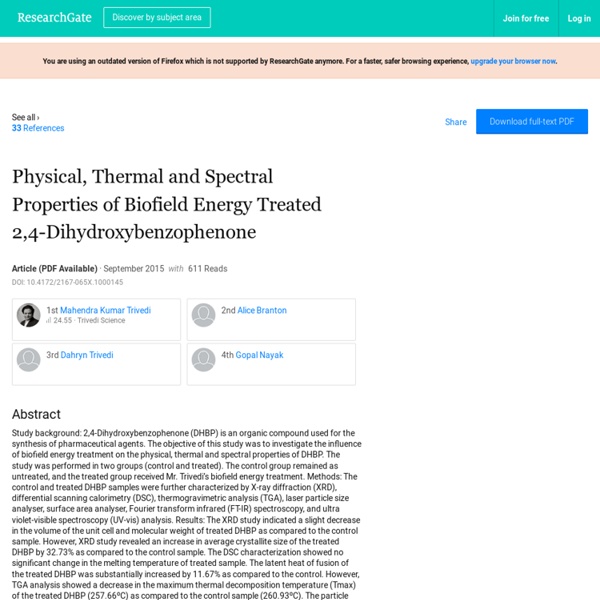Human Energy Impact on Thermal Properties of DHBP

https://www.researchgate.net/publication/283450293_Physical_Thermal_and_Spectral_Properties_of_Biofield_Energy_Treated_24-Dihydroxybenzophenone
Thermal Properties of DHBP after the Human Energy Treatment
Description Study background: 2,4-Dihydroxybenzophenone (DHBP) is an organic compound used for the synthesis of pharmaceutical agents. The objective of this study was to investigate the influence of biofield energy treatment on the physical, thermal and spectral properties of DHBP.
TGA Analysis of Biofield Treated 2,4-Dihydroxybenzophenone
Study background: 2,4-Dihydroxybenzophenone (DHBP) is an organic compound used for the synthesis of pharmaceutical agents. The objective of this study was to investigate the influence of biofield energy treatment on the physical, thermal and spectral properties of DHBP. The study was performed in two groups (control and treated). The control group remained as untreated, and the treated group received Mr. Trivedi’s biofield energy treatment.
Antibiogram Genotype & Phylogenetic Analysis of Biofield Treated Nocardia otitidis
Citation: Trivedi MK, Branton A, Trivedi D, Nayak G, Mondal SC, et al. (2015) Evaluation of Antibiogram, Genotype and Phylogenetic Analysis of Bioeld Treated Nocardia otitidis. Biol Syst Open Access 4: 143. doi:10.4172/2329-6577.1000143 Page 2 of 6
Menthol TGA Analysis - Evaluation of Energy Medicine
Description Thymol and menthol are naturally occurring plant derived compounds, which have excellent pharmaceutical and antimicrobial applications. The aim of this work was to evaluate the impact of biofield energy on physical and structural characteristics of thymol and menthol. The control and biofield treated compounds (thymol and menthol) were characterized by X-ray diffraction (XRD), Differential Scanning Calorimetry (DSC), Thermogravimetric analysis (TGA), and Fourier Transform Infrared Spectroscopy (FT-IR). XRD study revealed increase in intensity of the XRD peaks of treated thymol, which was correlated to high crystallinity of the treated sample.
Impact of Biofield on Thermal Stability of Thymol
0WordPress0CiteULike0 New Thymol and menthol are naturally occurring plant derived compounds, which have excellent pharmaceutical and antimicrobial applications. The aim of this work was to evaluate the impact of biofield energy on physical and structural characteristics of thymol and menthol. The control and biofield treated compounds (thymol and menthol) were characterized by X-ray diffraction (XRD), Differential Scanning Calorimetry (DSC), Thermogravimetric analysis (TGA), and Fourier Transform Infrared Spectroscopy (FT-IR).
View an Impact of Mahendra Trivedi Biofield Energy on Nocardia Otitidis
Abstract Nocardiosis is a soil-borne aerobic infection caused by Nocardia species commonly affects the respiratory tract. Nocardia otitidis (N. otitidis) is the key organism for non-mycobacterial tuberculosis. The current study was attempted to investigate the effect of Mr. Trivedi’s biofield energy treatment on N. otitidis and analyzed for antimicrobial susceptibility pattern, minimum inhibitory concentration (MIC), DNA polymorphism by Random Amplified Polymorphic DNA (RAPD) and 16S rDNA sequencing. The strain of N. otitidis (ATCC 14630) was divided into two parts, control and treated.
Menthol TGA Analysis- Study of Biofield Impact
Title: Structural and Physical Properties of Biofield Treated Thymol and Menthol Publication: Molecular Pharmaceutics & Organic Process Research Select license: Creative Commons Attributions-NonCommercial-ShareAlike
Experimental results of Escherichia Coli Antibiotic Sensitivity Assay
Study background: Multidrug resistant Escherichia coli (MDR E. coli) has become a major health concern, and failure of treatment leads to huge health burden. Aim of the present study was to determine the impact of Mr. Trivedi’s biofield treatment on E. coli. Methods: Four MDR clinical lab isolates (LSs) of E. coli (LS 8, LS 9, LS 10, and LS 11) were taken and divided into two groups i.e. control and biofield treated. Control and treated samples were identified with respect to its antimicrobial sensitivity assay, biochemical study and biotype number using MicroScan Walk-Away® system. The analysis was done on day 10 after biofield treatment and compared with its respective control group.
Related:
Related:



